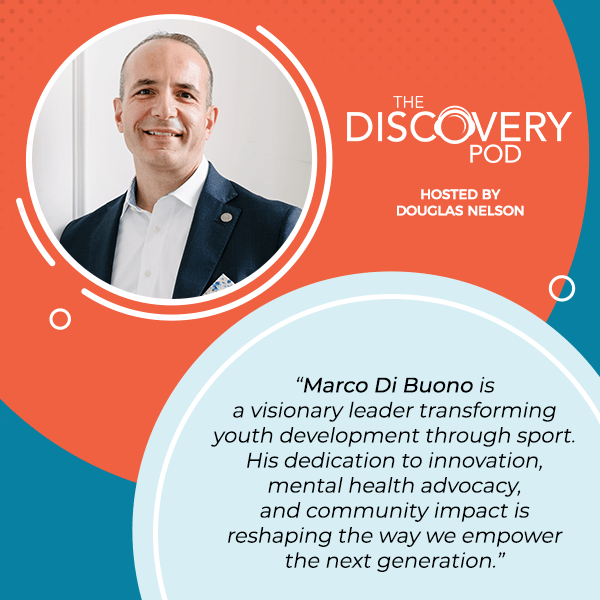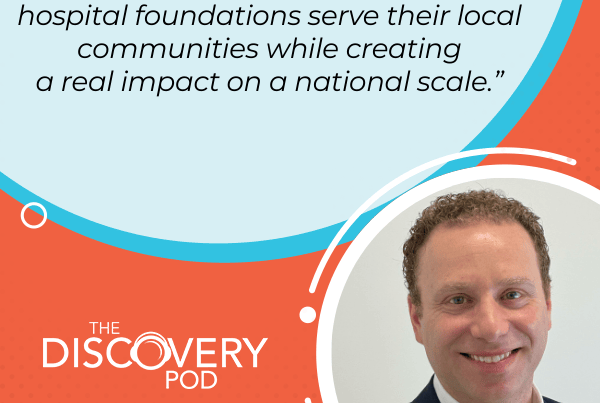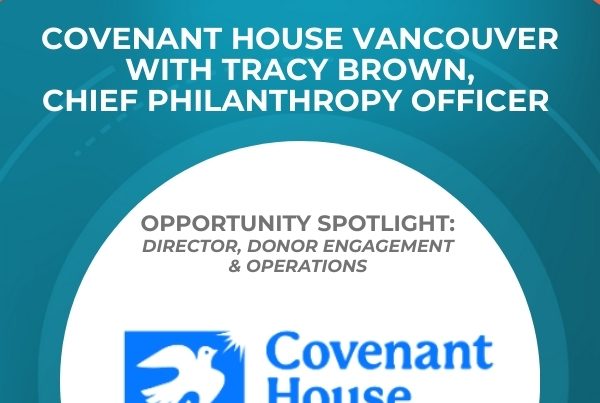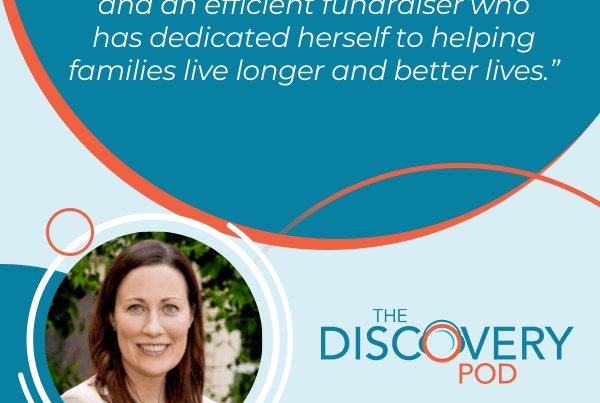
Canadian Tire Jumpstart Charities has been a cornerstone of youth support in Canada for two decades. In this episode, Douglas Nelson talks with Marco Di Buono, President of Canadian Tire Jumpstart Charities, about the organization’s 20-year history of supporting Canadian youth through sport and recreation. Marco highlights the importance of centering youth voices in program design, Jumpstart’s innovative approach to addressing mental health challenges in sports, and the development of a social value model that demonstrates a remarkable $13 return for every dollar invested in communities. Learn more about how Jumpstart is making a difference and get involved today!
—
Listen to the podcast here
Canadian Tire Jumpstart Charities With Marco Di Buono, President
In this episode, we have Dr. Marco Di Buono, PhD. Marco is the President of Canadian Tire Jumpstart Charities, an organization with a commitment to empowering children, youth, and communities across Canada through sport and play. During his time with the organization, the charity has more than doubled the size of its distribution. It reaches more than 400,000 children annually across Canada. You’ll know how they’re measuring that impact in a very thoughtful and innovative way in this conversation.
Marco has a deep sense of what the charitable sector is having worked at the Heart and Stroke Foundation of Canada and American Heart Association prior to joining Jumpstart Charities. He shares his perspective from the other side, having been a grant seeker and then a grant maker, and great advice for organizational leaders building out their understanding of social impact. Please enjoy my conversation with Dr. Marco Di Buono.
‐‐‐
Marco, welcome to the show.
Thank you. I’m very honored to be here.
The Impact Of Canadian Tire Jumpstart Charities On Youth
This is going to be a great conversation. I’m sure our audiences are going to get a lot out of it. Let’s get to it. Tell us a little bit about the Canadian Tire Jumpstart Charities and the role you play in Canada.
We’ve had the privilege of serving Canadian youth and Canadian communities for many years. Jumpstart was founded in 2005 with the singular focus to help kids access the benefits of sport, physical activity, and recreation. We’re uniquely positioned as a charity because we have the full backing of a multibillion-dollar enterprise in a Canadian corporation.
What that means is we have stakeholders and communities across the country who believe in the importance of investing in communities. Those are Canadian Tire dealers, our store staff, and our executives. We’re also able to leverage the capabilities and competencies of this multibillion-dollar corporation to help extend and amplify the reach of all the work that we can do with the resources at our disposal.
Since 2005, we’ve been able to help upwards of four million kids and communities from coast to coast to coast by investing somewhere in the vicinity of $300 million to enable affordable access to sport, physical activity, and recreation. We’re very proud of that. We’re most proud of the innovation that we’ve introduced into the ecosystem. I’m sure we’ll get into some of that over the course of our conversation.
The Role Of Sport In Youth Mental Health
It is such a remarkably good story to tell. It’s a feel-good story. Putting those dollars into something like youth sports sounds like a nice thing to do. We’ve had a number of guests on the show and we know a number of organizations we’ve worked with that focused on youth mental health. From your perspective and the perspective of your organization, what is the role of sport in youth mental health?
Sport has a much bigger value proposition than we give it credit in North America. We like to think of ourselves as a sport for development organizations. That notion of sport for development is underappreciated from a North American context. In essence, it recognizes that sport plays a role in physical and mental health, promoting pro-social behaviors or reducing youth offending. It even plays a role in upskilling youth to enable access to potential employment through better academic performance and participation.
Sport plays a role in physical and mental health promoting pro-social behaviors, reducing youth offending, and upskilling youth to enable access to potential employment. Share on XThese are all things that have been documented in the literature and studied by social scientists and sports scientist and so on. As it relates to mental health, there are a couple of dimensions. If you think of sport in its essence, it creates an opportunity for kids to bond with their peers. When you ask children why they want to play sports, there are two things that bubble up to the top. 1) They want to have fun. 2) They either want to make new friends or play with existing friends.
From a mental health perspective, having the opportunity to socialize and engage with peers is going to have massive benefits. The other thing we know from psychology, particularly about adolescence and adolescent mental health, is that the presence of an adult in an adolescent life is the number one predictor of well-being. Not all kids benefit from a home where they can count on a parent, a family member, or a caregiver.
We know that schools are struggling to even deliver the basic services that they need to promote education and well-being amongst children and youth. Having coaches in the community who can serve as adults and allow kids to open up and express the feelings and challenges that they’re going through can play a significant role in modulating health and well-being from a mental health perspective as well.
We see so many organizations trying to figure out how can they help and support youth mental health, whether it’s health care or social service organizations. Your organization has been there for a long time contributing to that. How are you seeing the increasing focus on meeting the need for youth mental health affecting the way you’re approaching the funding that you’re providing?
There are a couple of ways that we’ve approached this. As much as everyone wants to put the pandemic well behind them, there were a lot of interesting things that happened in the early days of the pandemic. If you recall, at least from a Canadian perspective, sports along with schools was among the first things to close and among the last things to reopen.
During that time, what we saw were coaches and youth activity leaders coming to us and asking for support in helping to better understand some of the mental health challenges that their participants were experiencing and how to help them navigate through some of those challenges. Immediately, we set in course in partnership with a lot of other organizations, notably the Coaching Association of Canada, upskilling resources to help coaches and youth activity leaders at a grassroots level better understand how to identify non-critical and non-urgent mental health issues with their participants and then how to help them navigate through some of that.
They’re excellent enduring resources that exist as part of the formal coaching curriculum that is still available. That is a real legacy contribution of the pandemic in terms of being able to upskill activity leaders in the sports space to deal with the mental health issues that their participants are facing. What we’re also doing is looking at innovative ways to address this more systemically within the sport ecosystem notably the way organizations outside of Canada have addressed this using sport as a tool.

Canadian Tire Jumpstart Charities: The real legacy contribution of the pandemic is the ability to upscale activity leaders to address mental health issues that participants are facing.
We’ll be implementing a new program in Canada called Head in the Game. It was developed by Beyond Sport, a UK-based organization. They piloted this program in the United States with phenomenal results. There are three components to the program, effectively upskilling the youth activity leaders that we did. We’re putting program dollars into well-designed sports, physical activity, and recreation programs intentionally designed to improve child’s mental health and well-being.
A third component is ongoing support and resources for non-critical mental health issues for participants and coaches. That’s 24-hour hotlines that a child can call into where they can speak to a subject matter expert at the other end of the phone who can help them navigate non-critical issues as they arise. We’ll be implementing that program, Head in the Game, with Beyond Sport in Canada throughout 2025 as an example of an innovative but simple approach to tackling mental health sports.
Lessons Learned From 20 Years Of Canadian Tire Jumpstart
Simple is a relative term there for sure. In 2025, Jumpstart turns twenty. I’m curious. What have you seen? What has the program learned over that long time working with sports across the country?
The number one thing that we have learned and that we try to implement every single day is to never forget the importance of centering youth, at least for us. Our focus is centering on the youth voice in how we approach our work. Turning back to the pandemic when everything was closed, we started to conduct surveys of participants and community organizations.
What we learned set us on the course to deploy the supports that we were able to deploy during the pandemic and effectively help organizations keep the lights on and their doors open during and afterward. Since then, we’ve conducted surveys of child and youth participation in sports. The first national survey since 2001, if you can believe it, we had 3,000 respondents tell us what they play, what they wish they could play, and what’s preventing them from doing it.
That’s where we derived the insight that the number one reason kids play, whether they’re playing competitive sports or recreational sports is because they want to have fun. It tears down the myth and misperception that a lot of sports leaders and some coaches have about the motivations that children have for participating in sports. The number one thing we’ve learned is to not make assumptions to center the youth and the decision-making. If we can design around youth, we design programs that will meet their needs effectively. We’re seeing that every day.
Designing programs with the input of the people you’re designing them for. It’s a revolution, Marco.
I know. God, help us. It’s so revolutionary in its approach. In the past several years, we’ve had movements that encourage design for us and by us, so to speak. What those approaches tend to forget is that it’s not just the demographic makeup from an ethnic and cultural perspective that is important but from an age perspective as well.
There are different needs at different ages and stages. If we’re a group of adults around the table, no matter how diverse that group of adults is, we’re going to miss the mark in terms of meeting the needs at the appropriate agent stage of development. It sounds revolutionary but almost anarchist. Truly, it’s so important to center that youth voice in the design of programming.
Centering the youth voice in the design of programming isn't just revolutionary—it's essential to meeting their needs effectively. Share on XInnovation And Its Role In The Social Profit Sector
I like that. In a couple of your answers, you’ve talked about the role of innovation and how your organization and funding have evolved over the last number of years, particularly since the pandemic. That idea of innovation in the sector is something that we and a number of our clients talk a lot about. My view is often the world outside of the social profit sector is often changing more quickly than the world inside the social profit sector, given your role, your connection to Canadian Tire, and that multibillion-dollar corporation you referenced. You see both. You’ve got a foot in both camps. From your perspective, what do you see is inhibiting the role of innovation in the successful implementation of innovations in our social profit sector?
I’m not sure where the origins of the aversion to risk in our social sector came from in Canada. You alluded to my ability to straddle both the corporate sector and the charitable sector in Canada through my role at Canadian Tire but even prior to this, I had the opportunity to work in a not-for-profit space in the United States. I was taken aback when I first started there at how much the sector there thinks of itself in the same way that the Fortune 500 companies do, and also the amount of investment they put into innovation, testing, learning to understand what will work and what will not work.
For example, I remember our CEO at the time had an innovation fund that she encouraged all senior staff to apply to for innovative ideas that could be concept-tested, explored, and potentially scaled if they were successful. If they weren’t successful, that’s fine. The whole idea was to test, learn, and explore. We don’t have that approach. It’s unique to the not-for-profit space in Canada that we have this massive aversion to risk.
It may be a confluence of things, whether it’s an over-interpretation of CRA guidelines and an assumption around donors’ interests and not wanting to take risks with the limited and precious resources that are available but it is something that I’ve seen is unique to the Canadian sector. It’s unique specifically to the not-for-profit sector in Canada.
If we don’t test and learn from non-critical failures, how are we going to know what has an impact and what works? Rather than look at it as a poor investment, we need to reframe the educated risk-taking as a way to learn what’s going to generate the biggest impact and see it as part of our fiduciary accountability to ensure that donor dollars are being stewarded properly.

Canadian Tire Jumpstart Charities: If we don’t test and learn from non-critical failures, how are we going to know what really has an impact and what really works?
Going back to what we were talking about the way to ensure innovation successfully is by connecting with the people who are the beneficiaries of the participants. One of the barriers to innovation is that a number of organizations that we’ve worked with and certainly ones we’ve observed are afraid to ask that question of their participants or the people that they serve. They understand on some level that they’re going to be required or asked to fundamentally change how they’re working with those groups and individuals. That’s terrifying to think about it.
Change is always terrifying, especially when it’s not concrete and it’s a little bit nebulous and ambiguous. Your beneficiaries may have some of the answers but maybe just enough to create frameworks that guide your decision-making and not enough to articulate the tactics that are going to fit within that framework.
I can appreciate that it creates a little bit of fear and consternation but at the end of the day, the most important data point that we have is the end beneficiary of the services or products that we’re trying to deliver. Ignoring that voice borders on irresponsible. There does need to be a more significant reconciliation of that voice in the way that we approach the work that we do as a sector.
How Marco Transitioned Into His Role At Jumpstart Charities
You mentioned your work prior to Jumpstart Charities. I’m sure many of our audiences are seeing your picture clicking and hearing your voice for the first time. Their first thought is how well-spoken you are and how great you look in the photo. The second thought is, “How do I get a job like Marco?” Tell us a little bit about how you got into this role. Many of us in the social profit sector start on the fundraising side or the grant-seeking side and wonder about one day being the one in charge of giving the money away. Tell us how we do that, Marco.
My journey on the surface does not look like it makes any sense whatsoever. Thankfully, there’s a narrative there, and not just one that I can look at in hindsight. It’s something that has always guided the decisions I’ve made throughout my career. As many people with the academic background that I have, I aspired to be a physician or a pediatrician, quite frankly. I’ve always been passionate about child and youth wellbeing from a very young age.
When I failed, like many people, to get into medical school and reach that goal, I looked for alternative pathways. My first opportunity after graduate school where I studied nutrition science was to help the Canadian food sector navigate the complexities of the childhood obesity epidemic in Canada. I joined a multinational food company around the time that there was heightened sensitivity around the role of the food industry in childhood obesity. I partially naively thought that if I could get in there, I might be able to impart positive change.
It did have an influence. The company was progressively minded and I was able to do some great things but it wasn’t advancing as quickly as I could. From there, I made my first transition into the social impact sector through a role with the Heart and Stroke Foundation of Canada. That’s when I started to appreciate the breadth and depth of roles that the sector had to offer.
I started on the program side but I was given an opportunity to get into fund development while I was there, which broadened my skillset. I had no aspiration at the time to become an executive director or president of a charity. “Learning is a gift,” as our CEO at the foundation used to say. I thought, “If you’re going to give me an opportunity to learn about fund development without having to take a step back in my career, I will embrace that opportunity because who knows where this might take me.”
I had an opportunity because of an opportunity that was afforded to my wife through her employer to move down to the United States where serendipitously, I was able to work with the American Heart Association. It wasn’t by design. It was a sheer coincidence that they had a role. There too, I was given another opportunity to extend my skillset. For the first time in my career, I had responsibility for revenue generation. Not through fund development but through the actual commercialization of some of the American Heart Association’s products and services.
I had a P&L, as they say, under my purview. That was a heck of a learning experience. The total of that afforded me the opportunity to make the transition at Canadian Tire. The thread that links all of those things, including the thread that got me to Canadian Tire Jumpstart Charities, was this passion for child and youth wellbeing at the outset. That has always guided my decision-making.
When we knew we were coming back to Canada and I wanted to look at another role that would advance my career, that’s when I started to intentionally look for organizations where there was a pathway for me to potentially get into a very senior leadership role. From there, it was finding the right mentors and opportunities, developing the relationship with the board, understanding what their expectations were, and embracing those opportunities to learn and grow in the role, which eventually got me to the position that I’m at.
Some readers are going to be like I make it sound so simple but it’s not. It’s hard work. I had to take stock of the limitations that I had as an individual and the skillsets that I needed to embrace and learn in every single step of that journey, whether it was understanding fund development and being responsible for a P&L. When I got into the role I have, understanding board stewardship at a level that I wasn’t exposed to in my previous roles.
All of these things, one incremental step at a time, led to my ability to position myself as truly ready and capable to take on the leadership role. It was a long, slow, and important journey at every step of the way and not always intentional. Some of these things came up serendipitously but having a growth mindset to embrace them and being prepared to tackle them to the best of my ability.
Surprises In Transitioning From The Charitable Side To Granting
That growth mindset counts a lot for managing your career but instilling that in others through your work. I’m curious what assumptions or presumptions you may have had about the role that you’re in as you started and put your hand on the door for the first time and pulled it open. What surprised you most about making that transition from the charitable side to the granting side?
There were so many things that surprised me having come from an organization like Heart Stroke and even the American Heart Association where you had a group of individuals who were subject matter experts in granting and notwithstanding the governance around that with the board and board committees. You are largely given the authority to make decisions and move ahead with the deployment of capital and resources as you need to.
Entering a space like this where there are a multitude of stakeholders, all of whom are very passionate about what investments in their community mean and the importance of those investments. It wasn’t as straightforward as demonstrating competency. It was a real question about engaging with those stakeholders and bringing them along for the journey.
It modified the way that we designed our granting process to make sure that as many of our stakeholders as possible had transparency into that process and could take part ownership in that process and the result in their respective communities when those resources and that capital were deployed.
That in and of itself was the biggest lesson. We weren’t doing this alone. We were doing this with tens of thousands of employees and other stakeholders from this enterprise who had a real vested and passionate interest in the outcomes we were trying to generate. From there, it unpacked a whole bunch of other things like the opportunity to leverage capabilities that we never would have thought of as relevant to the work that we’re doing but allowed us to amplify or extend the impact.
I sometimes tell my peers, “We can extend the $30 million that we’re able to deploy to be much bigger than the $30 million that it looks like.” With all these capabilities, we’re able to extend to our partners, whether it’s leveraging supply chain capabilities of Canadians to help organizations move material and resources or access supplies in our store network for equipment and other resources. Also, mobilizing volunteers to help build capacity. There are a multitude of ways we can extend the reach of that $30 million to make it seem much more impactful than it is.
Looking Forward To New Programs And Innovations At Jumpstart Charities
You certainly have done that in your time with the organization. You’ve nearly doubled the reach of the number of kids that are impacted every year to 400,000 in 2024. I’m curious. With that trajectory and the new programs coming online. Marco, what are you looking forward to?
The number of kids is a great output. We’re trying to improve everyone’s understanding of the true value proposition in sports. One of the things we’re most excited about is some of the tools we’re bringing online that help quantify and articulate that impact in a much better way than we ever have before. We were able to explore with organizations that do this work well outside of Canada the use of estimated social value tools to achieve this.
We’ve been working in particular with groups out of the UK that have supported the articulation of estimated social value as an outcome measure since the 2012 Olympics. We’ve developed a social value model that’s applicable to our work, which effectively ascribes $1 value to the reduction in youth offending and health care utilization that can be achieved through sports participation and the improvement and employability that can be achieved through skill development by sports participation.
In effect, aggregating what it showed for us in 2024 was that for every dollar we invested in a community through our granting programs, we generated $13 in savings within twelve months for that community through reductions in healthcare utilization, youth offending, and improved employability. That $13 to $1 multiplier is a hell of an ROI.
When we position it this way, whether it’s political leaders, thought leaders, or potential funders, they have a much better appreciation of how significant the impact is. They understand that sport is the vehicle. It’s the means, not the end itself that we’re trying to use, not achieve. We’re able to quantify via this means of sports participation the outcomes that we can achieve within a respective community.
That $13 to $1 social return on investment is a powerful figure. I’m curious. What did you say when you first heard or saw that number on the page?
Two things. One, I was a little bit taken aback by the magnitude of the return but at the same time, it was also a realistic number. On the one hand, I was surprised by how big it was. On the other hand, I thought, “It could be bigger. Let’s be grateful that it’s realistic. It’s going to resonate with people.” The great thing about this tool is that it’s not so much that it helps us articulate this impact but it’s a tool that we want to mobilize amongst our ecosystem so that it will allow our partners and the community organizations we support to make better decisions around how their programs are designed and deployed.
They can use it in real-time to estimate the value that they can generate through the programs that they’re designing. One of the insights we got, for example, in doing this work is that the biggest predictor of social value is the length with which a child participates in a program. Right away, we can tell the organizations we support to invest in the duration of programming versus something else.
The second biggest predictor is the ratio of staff to participants. The more staff you have for your participant, the better the outcomes are going to be. It’s not a surprise. The data validates and confirms that. The second thing you’re going to do is to invest in well-trained staff to deliver this program intentionally over a longer period.
The biggest predictor of social value is the length of time a child participates in a program. Invest in duration and staff to really generate an impact. Share on XRight away, we’re providing more support to organizations and say, “This is where you want to make your investments to generate an impact with the kids you serve. Don’t worry about scaling or replicating the program. Worry about extending the duration and hiring more staff to deliver the program in a well-designed way. That’s how you’re going to get better outcomes.” We’re hoping that this is going to be very useful for the organizations we support and for them to be able to extend their work in a meaningful way.
It’s encouraging and inspiring to hear how you’ve taken on that role of social impact measurement. It’s something in our sector organizations struggle mightily with. I’ve seen everything from a 1-to-1 return. It’s a push but we’re helping people. It’s okay that organizations are trying to sell or communicate an infinite return on every dollar.
In spirit, I’m with them but my head has a hard time following that. Those credible metrics and specific examples you shared are helpful for people. If people want to know more about Canadian Tire Jumpstart Charities or understand more about the model that you described, what’s the best way for them to learn more?
They can learn more about the charity on our website. We’ve got plenty of information about some of the programs we deploy and things along those lines. To learn more about some of these tools that are not quite publicly available yet, by all means, reach out via LinkedIn. I’m always open to folks reaching out for guidance, advice, and insights. We’d be happy to share more about the work we’re doing and point you in the right direction in terms of where you might find ways to adopt the same methodology through your organization.
It’s a tremendous offer. I appreciate that. By reputation, both you and your organization have so much a deep well of credibility in our sector. You’re doing excellent work in supporting communities across the country. On behalf of all those people that you don’t get to hear from, I want to say thank you for your work, the work of your colleagues, and the great work that you do. Thanks for being on the show.
Thank you for having me and for those very kind words. I’m grateful to hear that. It’s reassuring to know that we’re doing something right.
A lot right and more to come, I’m sure. Thanks a lot, Marco.
Thank you.




